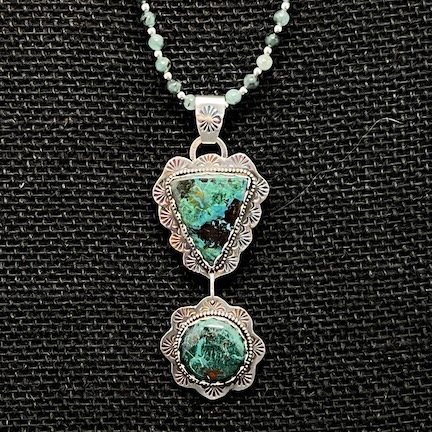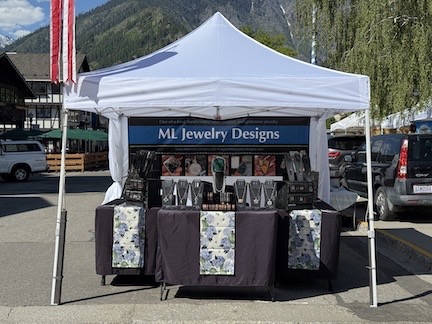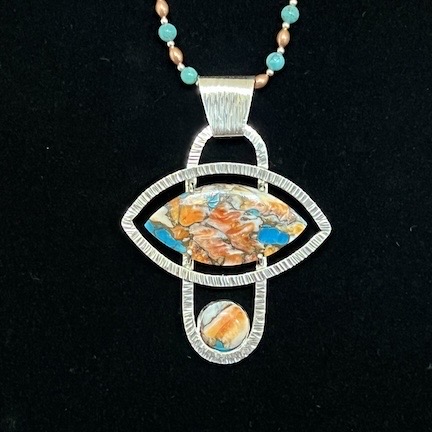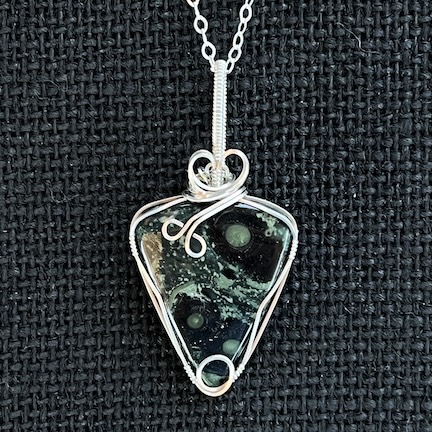I take an objective, dollars and cents look at the various ways I can sell my jewelry to see how they stack up financially.
Last weekend, I made the nearly 5-hour drive to Sequim, WA to attend a 3-day Lavender Festival that featured, among other things, artists and vendors selling their wares. I was one of those artists.

I was very pleased that this double pendant sold for $229 at the Lavender Festival, along with the $99 sterling silver and emerald necklace I’d paired it with. (Those beads were expensive!)
I’ve done plenty of art shows before. I’ve done a handful here in Washington State and a handful down in Arizona. I’ve had mixed results, mostly depending on the stage I was in in my silversmithing journey and the kind of show I was attending. Some shows are good for low-end items, other shows are good for fine art items. My work straddles those two worlds, for a variety of reasons.
But rather than talk about the evolution of my work, I want to talk about something I know well: the finance end of things. After all, I do have a BBA in Accounting with Highest Honors from Hofstra University. (LOL.) And even though I don’t use that degree in my daily work, I haven’t forgotten a lot of what I learned along the way, including marketing and finance. It is, after all, what makes it possible for me to handle the financial records and do the marketing for all of the businesses I operate, even if I can never really count how many there are.
And here’s what I learned about the various ways I sell my work.
Item Costs
When you’re making something for sale, you need to get a good handle on what each item costs to make. Costs include a few things, some of which are more obvious than others:

Remarkably, these wire-framed pendants still sell. I make them when I’m sitting idle in my booth at a show. They are the least expensive pendants I make, but with the price of silver rising 50% in the past two years, I’ve had to raise my prices on them, too.Materials cost. I’m using sterling silver and gemstone cabochons for most of my work. There was a definite identifiable cost to acquire these materials. I try to record the cost of materials where I store those materials. There’s a cost code on a sticker on the bottom of every cabochon in my collection. I also write the cost per square inch on flat pack silver packages and the cost per inch on the spools or coils of silver wire. Although I’m not quite anal enough to track the exact materials cost for every item I make, I do have a fair idea. I can tell you this: bezel-set stones on backplates cost a heck of a lot more for materials than wire framed pendants.
- Supplies cost. I use a variety of supplies when making jewelry. Solder, flux, torch fuel, sanding and polishing wheels, etc. In most cases the amount of supplies I use are minimal, but they were purchased at a cost and I need to keep that cost in mind when calculating what an item costs to make.
- Want a good idea of what kinds of tools I use? Watch this YouTube video tour of my shop.
Tools cost. Tools are the things I use to manipulate the metal and can include hand tools like pliers, wire cutters, hammers, and saws; desktop tools like my flex shaft, rolling mill, metal shear, and torches (Big Shot with butane refills and Smith Little Torch with propane and oxygen tanks); and other tools like mandrels, templates, soldering boards, annealing tray, third hand, anvil, etc. There are literally too many to list. Tools can be used over and over — often for years and many projects — but they still cost money to obtain. I have literally thousands of dollars invested in shop equipment and all of that is eventually paid for with the sales of my jewelry.
- Time cost. Time really is money and my time ain’t cheap. If it takes me 4 hours of active work time to make a pendant, don’t you think I should be compensated for it? I build the cost of my time into my price.
I’m fortunate. My jewelry studio is in my home. I don’t need to rent a space and deal with associated costs. Other folks do. That has to be taken into consideration as well.
These are the costs of actually making items. Selling them is another story.
Cost of Sales is More than Item Costs
Artists can sell their work one or two ways: directly or through a middleman. Each way has its own costs.
Direct Sale: Selling in Person
This is the sweetest way to sell your work: sell it directly to someone who wants it who is meeting with you face to face. This could be a friend or a friend of a friend or perhaps at another place where you happen to be with your merchandise.
The best example I have of this is selling at an Artists Table at a boating event I attend every year. There’s one table for each artist (unless you get there early and hog multiple tables) and there’s no fee. For three hours, other event attendees check out what’s for sale and buy. I bring just a table cover and about a dozen pendant displays. I bring all of my pendants and about 1/4 of my other inventory. And I sell at retail price. My only cost is packaging and credit card fees. My return is roughly 95% at these events. I love them because they’re short and sweet and I’m there anyway. I can set up and tear down in about 15 minutes. Of course, I don’t make very much money at these events, but it’s nice to get compensated for my work.
Direct Sales: Selling online
I have an online shop that I use to sell my work directly to customers. This is actually the least expensive way for me to sell because I use an extremely cost-effective platform to sell on: Square. Square is my credit card provider and when I sell online, it just charges me the credit card fee, which is generally around 3%. I still have to buy packaging (my cost) and ship items out (usually my cost because large sales ship free). But looking at an example, suppose someone buys a $50 pendant, which ships free. I spend about $1.50 for credit card fees, $1.00 for packaging, and $4 to $10 on shipping. If I keep it as cheap as possible, I net $43.50 on that $50 item or 87%.
I should note here that not all online sales solutions are this cost effective. Etsy, for example, will charge a percentage of the sales price after it already charged you to list it and can charge an additional marketing fee if it claims people found your item through one of its Google ads. You can learn my thoughts about Etsy and why I won’t use it here.
I like direct sales through my website. It’s easiest and most cost effective for me to do.
Direct Sales: Selling at Art Show and Other Venues
I do most of my selling at art shows. Art shows have a variety of costs associated with them.
- Jury or application fees, which range from $10 to $50, are non-refundable and you’ll pay them even if your work isn’t judged good enough to be part of the show.
- Booth fees can range from $35 to $1,200 or more, depending on the show. You’ll pay those to get your booth.
But that’s not where the costs end. You still have to get to and from the show, pay for overnight accommodations if the show is more than one day, and cover the cost of fees for credit card sales.
And some shows require you to pay a percentage of sales. One I do quite regularly charges only $35 for my booth for the weekend — which can be up to 5 days, depending on how summer holidays fall — but also keeps 21% of all sales. They also handle sales centrally, so at least I don’t have to pay credit card fees. The good thing about this arrangement is that if I have a crappy weekend, I can’t lose money. But, on the other hand, if I have a kickass weekend, I still gross only 77-78%.

My booth at a recent Leavenworth show. Canopy, tables, table covers, table runners, necklace displays, earring displays, bracelet displays, signage, chair, point-of-sale supplies. It all costs money.
And don’t forget your booth. You’ll need a white fire retardant canopy with zip-up sides, four 30-40 pound weights to hold it in place, and tables, walls, or other display equipment. Just outfitting your booth could cost $1000 or more; mine has a tent, three tables, table covers, dozens of custom pendant display “necks,” bracelet displays, and special boxes to display earrings. You’ll also need a vehicle to schlep all that stuff around. Fortunately, these are mostly one-time expenses, but you need to maintain and replace these items periodically. Before my last show, I re-finished every single one of my pendant displays. And two months ago, I replaced my aging canopy.
Finally, your sales depend quite a bit on a few factors:
- Is your work with your price points a good match for the people attending the show? If you’re overpriced or your work is too highbrow for the people attending, you won’t get sales. If you’re underpriced, your work could be seen as junk.
- What’s your competition like? I sell jewelry, which is often a very popular category at art shows. A smart promoter will use the jury system to select jewelry artists whose work is different. Then they’ll lay out the show so all of the jewelry artists aren’t together. If my work is very similar to another artists, we’ll have to split the sales for work like ours between us.
- Is the show well attended? If people don’t show up because the show was poorly advertised, promoters charge a hefty entrance fee, or the weather was crappy for an outdoor event, sales will suffer.
- Are people actually spending money? One of the things I hate about doing shows in tourist towns is that show browsers might just be walking around to kill time. The state of the economy comes into play here.
- Do you accept credit cards? If you don’t, you’re in the wrong business. Cash might be king, but few customers use it these days.
Either way, you have to remember the other costs of direct sales, which includes packaging. My packaging is simple: drawstring bags for pendants and plastic zip bags for earrings on cards. For multiple item purchases, I have larger drawstring bags. But other vendors might have bubble wrap, boxes, shopping bags with tissue paper, or more. All of these things cost money and need to be considered as part of the cost of sales.
So let’s look at some numbers. I’ll compare a recent weekend at Leavenworth Village Art in the Park with the Lavender Festival in Sequim.
| Item | Leavenworth (July 3-6) | Sequim (July 18-20) |
|---|---|---|
| Days | 4 | 3 |
| Jury Fee | $15 | $25 |
| Booth Fee | $35 | $495 |
| Overnight Lodging | $0 (home) | $100 (dry camping) |
| Gross Revenue | $2,094 | $4,064 |
| Commissions | $440 | $0 |
| Credit Card Fees | $0 | $109 |
| Net Revenue (excluding travel costs*) | $1,619 | $3,335 |
| Percentage of Gross | 77% | 82% |
—
* I excluded travel costs because I figure that driving to and from Leavenworth 4 times is about equal to driving to and from Sequim once, despite the much longer distance to Sequim.
My takeaway from this? My percentage return was only 5 percentage points higher in Sequim for the Lavender Festival than it was in Leavenworth (a tourist town) on a holiday weekend.
But the interesting thing to remember here is that my percentage return in Leavenworth will always be the same because of their commission fee structure: 77-78%. If I’d grossed $5,000, for example, in Sequim, my return percentage would have been closer to 85% (even considering more credit card fees). But if I’d grossed just $3,000 in Sequim, my percentage return would have been about 76%. Clearly, the more expensive a show is to attend, the more you have to sell.
I’ll tell you why the percentage return is important in a moment, although I expect most of you to be able to figure it out.
Middleman Sales: Consignment
I want to start out by saying that I hate consignment sales.
In consignment sales, you drop off some of your merchandise with the owner/manager of a shop or gallery and they sell it for you. Sounds good, right? Well here are some of the problems:
- Consignment fees. The shop or gallery keeps between 20% (which is crazy low and pretty much unheard of these days) to 50% (which is crazy high). The average I’ve paid is 35%-40%. (I will not sell on consignment if they want 50%.) Take 100% and deduct that percentage and you get your percentage return: 60% to 65%. To be fair, it’s easy, takes hardly any time at all, and has no other costs like credit card fees or packaging.
- They have your inventory so you can’t sell it. You can’t sell something you don’t have. And if they don’t sell it, it doesn’t get sold.
- There’s no provision for loss due to shoplifting. If someone steals your work from where it’s displayed in the shop or gallery, it’s your loss. After all, the shop or gallery hasn’t paid you for it.
- If they go out of business you might lose your work. I’ve heard these horror stories. A shop goes out of business and the owner/manager disappears with all the inventory, never to be seen again. This has not happened to me, but that’s because I’m very careful about who I leave items with on consignment.
- You have to rely on their honesty. If they’re dishonest, you work will disappear and you’ll never see a penny for it. Again, I don’t think this happens very often.
- Items can be shop worn or broken. I can’t tell you how many times I’ve gone to a gallery I work with to give them new items and get items back that are either severely tarnished — we are talking about silver after all — or broken. That means I need to work on them before I can put them back into my inventory and sell them.
The main reason I don’t like consignment sales is because I have to keep track of what’s out there. Letting inventory sit elsewhere, unsold or perhaps not even on display, is also problematic. I currently sell on consignment in only two places and I’m not bringing anything new to one of them.
Middleman Sales: Wholesale
Wholesale is a lot like consignment sales but once you sell it, it’s gone. You don’t have to track it or worry about getting it back in bad shape or worry about it getting stolen. You sell it and it’s gone.
The drawback, of course, is that the buyer wants a deep discount — perhaps as much as 50%. I’ve been lucky so far. I’ve done all of my wholesale sales at 35% with payment by check right on the spot. Although that means my percentage return is only 65%, at least the item is sold with zero additional cost or effort on my part.
Needless to say, if I’m going to use a middleman, I want it two be a wholesale client.
Why the Percentage Return Matters
Let’s put it all together now.
When you make an item, you have direct and indirect costs as discussed at the beginning of this article. When you sell at item you have additional costs. You need to price your item with a profit margin that makes it profitable to sell no matter how you sell it.
Suppose I make a pendant that takes me 4 hours and uses about $15 worth of silver and stones. I price my time at $25/hour (which is a steal). So my direct costs are $115. Add another $5 for the cost of supplies and a portion of the equipment costs. Now we’re up to $120. If I price this item at $199, I’ve got a 65.8% profit margin. (Calculate as (199-120)÷120.) So if I sell it at consignment and they get 35%, I’m barely breaking even.
I have three options:
- Price it higher
- Accept less for my time (or work faster)
- Don’t sell anywhere I’ll make less than 65.8% percentage return
If I sold this at Leavenworth or at the Lavender Festival, I’d still only have a profit margin of 12% or 17%. That means that for every $1 of costs, I’d earn a profit of 12¢ or 17¢. Ouch.
This is the problem faced by all artists and makers. People don’t understand our costs to make or sell. They just see the end product. And then they value it based on what it might cost in Walmart or on Amazon or from an “artist” who has her work mass produced overseas with inferior quality materials — maybe silver plate and plastic “stones”? — and passes it off as handmade.
Advancing My Art

This is probably the weirdest piece I ever made. Thick, square hammered sterling silver wire with two Kingman Turquoise and orange spiny oyster shell cabochons set in it. I showed it for several months before it finally sold in Leavenworth, along with the silver, copper, and turquoise necklace I’d made to go with it.
Right now, I’m in an in between world. I’m still making low end items like certain earring styles and wire-framed pendants. These are priced to sell at tourist art shows and festivals. But I’m also making better quality, more artistic items that some folks refer to as “statement pieces.” These take a lot of time and effort to make with high quality materials and specialized tools. I’m charging more money for these things because I have to.
Unfortunately, the only way to sell these items is to attend better art shows. The better art shows have higher booth fees. So it’s a gamble. Is my work good enough to get into the show? Once I’m in, will I get the sales I need to not only break even on the show itself, but to get the percentage returns I need to actually profit?
I think the shows I attend this winter in Arizona will answer that question once and for all.
Discover more from An Eclectic Mind
Subscribe to get the latest posts sent to your email.

